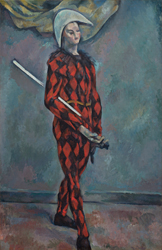French, 1839–1906
Paul Cézanne painted four works with Commedia dell'Arte subjects between 1888 and 1890—three isolated Harlequins, of which the work to the right is the largest, and a Mardi Gras scene with Harlequin and Pierrot. The Mardi Gras scene is the most descriptive and probably the first work in the series, while the present painting—devoid of any action and with only a corner of the yellow curtain remaining to hint at the stage—represents a more abstract phase in Cézanne's development of the theme. The artist first sketched his son in a Harlequin costume in late 1888, upon moving to Paris, where Carnival festivities were popular throughout the 19th century. His interest in the subject may have been reinforced, however, in late 1890 when he returned to his hometown of Aix, where Carnival had recently been revived, following a century-long banishment.
Paul Cézanne. Harlequin, 1888–1890. National Gallery of Art, Washington, Collection of Mr. and Mrs. Paul Mellon, 1985.64.7.

